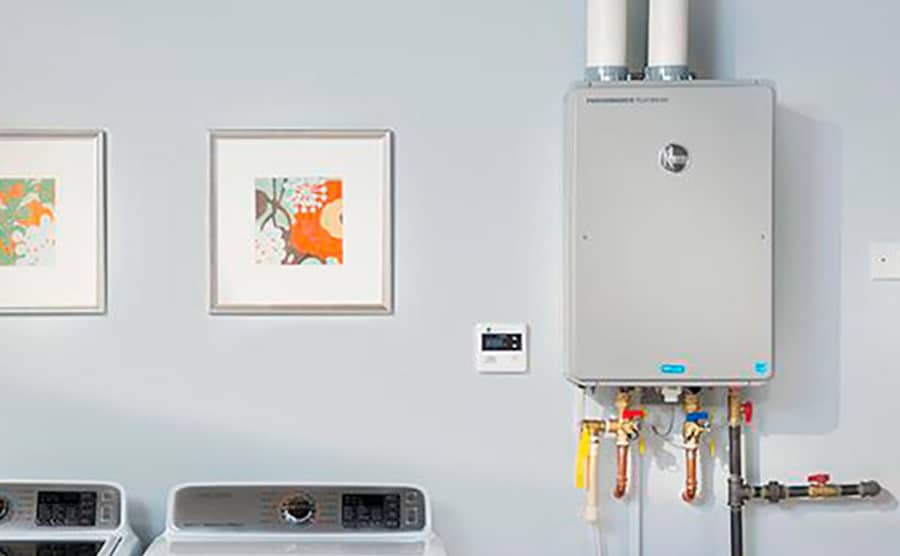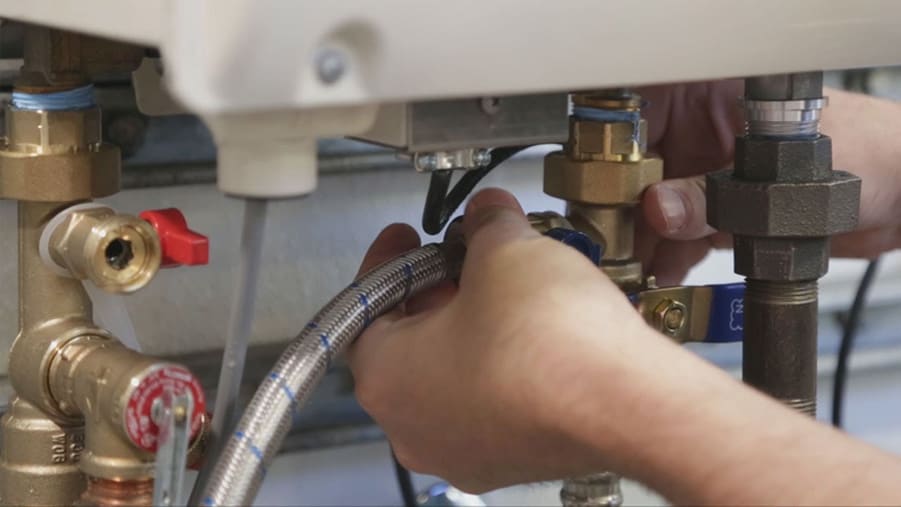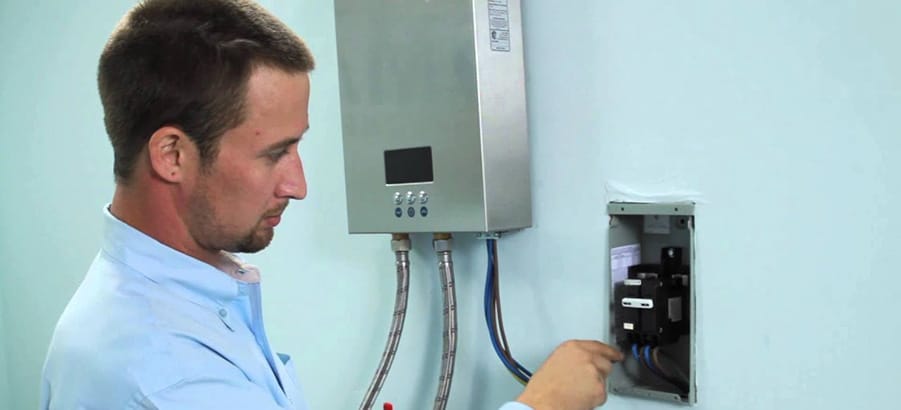
Tankless water heaters are rapidly overtaking tank water heaters as the primary choice in modern homes. They use less energy, save money, and take up less space than a traditional tank heater. But you might be wondering if they last longer than storage tank units.
So, how long does a tankless water heater last? A tankless water heater will typically last for approximately 20 years. Manufacturers don’t guarantee a life expectancy of over about 10 years. However, with proper maintenance, most tankless water heaters can last 20 years or longer.
This article will explain the answer to this question in greater depth. Some of the topics we’ll cover include:
- Why tankless water heaters last longer than tank heaters
- What can shorten a tankless water heater’s lifespan
- How to properly maintain your tankless water heater
- Tankless heaters vs. tank heaters: advantages and disadvantages
- Electric tankless units vs. gas-powered tankless units
Why Tankless Water Heaters Last Longer than Tank Water Heaters
If you’re in the market for a water heater with improved longevity, a tankless water heater is a better choice than a tank heater. This is the case for a few reasons.
Less corrosion
Most tank water heaters are made out of steel, a substance at high risk for rust and corrosion.
Tank water heaters prevent corrosion by using a sacrificial anode rod ‒ a cylindrical piece of metal that sits in your water heater tank and rusts in place of your metal tank shell. These rods typically need to be replaced every few years. One of the primary risks with a tank water heater is forgetting to replace the sacrificial anode rod and having your tank corrode and leak as a result.
You don’t run this risk if you have a tankless water heater. As there is no tank for water to sit in and rust, there is no need for a sacrificial anode rod that you might forget to replace.
That isn’t to say tankless water heaters can’t corrode. There is always a chance of corrosion in any place where water and metal make contact for extended periods of time. The risk of corrosion is still significantly lower in tankless heaters, though.
Less sediment buildup
Another reason tank water heaters break down is sediment buildup. As the water in the tank gets heated, minerals like calcium and magnesium separate from the water and build up in the tank’s bottom. Excessive sediment buildup can cause several problems:
- Less hot water available
- Uneven water temperature ‒ constantly fluctuates between lukewarm and hot.
- Increased energy costs
- Annoying popping sounds when the heating process is occurring.
If you want to mitigate issues caused by sediment buildup, you’ll need to flush your water heater at least once per year.
While this process is a relatively simple one that doesn’t necessarily require a professional’s help, it’s another maintenance task you need to remember to do regularly. If you forget, you run the risk of decreasing your tank water heater’s lifespan by a considerable amount.
As tankless water heaters don’t have tanks, you won’t have to deal with these kinds of severe sediment buildup issues. That isn’t to say tankless water heaters are immune to sediment buildup, though. Any hard water source will cause issues, and your tankless heater will need to be “descaled” of mineral deposits regularly.
What can Harm a Tankless Water Heater’s Longevity?
While tankless water heaters definitely have fewer potentially critical issues than tank water heaters do, they aren’t perfect machines. Several potential issues could cause a breakdown and a shortening of your water heater’s lifespan.
Corrosion
While corrosion is less of a problem in tankless water heaters than in tank heaters, it can still happen. And when corrosion does occur in a tankless heater, the consequences can be more severe than if a tank heater corrodes.
For starters, tankless heaters are small devices with many sensitive electronic components packed tightly together. If a small bit of corrosion causes the tiniest of leaks, it could spell disaster for your heater’s electronic parts. And if the damage is pervasive enough, you might need to trash the entire heater and cough up the cash to buy a new one.
Another potential issue caused by corrosion takes place in gas-powered tankless heaters. Condensation can slowly drip onto the gas burner, which can eventually cause so much corrosion that the gas supply is partially or entirely blocked. This might can prevent the gas burner from igniting, which will render your water heater ineffective until you repair or replace it.
Tankless water heaters installed outside will likely have a shorter life expectancy. Exposure to the outside elements can cause a tankless water heater to wear out prematurely.
Improper installation
A water heater that hasn’t been properly installed is a water heater prone to some serious issues. If you performed a DIY installation or hired someone without a professional plumbing license to do it for you, there could be some issues with the installation.
One possible installation issue in gas-powered tankless heaters is a faulty connection to the gas supply line. If there are any imperfections in the gas supply line connection, a dangerous gas leak could occur. Couple those gas vapors with the water heater’s ignition flame, and you’re at serious risk for an explosion.
If you have an electric tankless heater, you need to make sure the existing wiring in your house can handle the energy demand that the heater will place on it. If it can’t, there’s a slight chance that the wiring could short and start an electric fire.
Cost of repair
The internal workings of tankless water heaters are typically more modern and digitized than their tank counterparts. While these modernized components make tankless heaters more efficient than tank heaters, they also place a greater strain on your wallet when you need repair to replace them. If money is tight, replacing some of your tankless water heater components might be an expense you can’t afford.
You also need to be concerned about repair costs if a licensed plumber didn’t install your heater. Many water heater manufacturers won’t honor their warranties if the unit wasn’t installed by a professional, and you might have to pay hundreds or thousands for a surprise repair that you thought would be covered.
How to Increase Your Tankless Water Heater’s lifespan

While we all wish water heaters were a “set it and forget it” type of machine, this is unfortunately not the case ‒ especially if you want your tankless unit to last the full 20 years expected of it. If you want to help your heater reach old age, here’s an essential maintenance task you can perform:
Descale your heater regularly
The most important maintenance task you’ll need to perform is the descaling of your water heater. Though calcium buildup is much less of a problem in tankless heaters than in tank heaters, it can still cause problems.
While descaling is an essential maintenance task, it’s not at all complicated. You can do it yourself if you have the following materials:
- 90 minutes of free time
- 4 gallons of white vinegar or professional descaling solution
- 2 drain hoses (you’ll typically need a 3/4 inch connection)
- A 5-gallon bucket
- A tankless water heater descaling pump
These items can be purchased separately, but it’s easier to buy a complete descaling kit premade for removing water heater sediment. If you don’t have the materials required, I recommend using this My PlumbingStuff – Tankless Water Heater Flushing Kit (available on Amazon).
Step 1: Cut power to the water heater.
If you have an electric heater, go to your circuit panel and cut the power to the heater. You can also turn off the power on the heater itself to be safe, but it’s not necessary.
If you have a gas-powered heater, simply turn the valves counterclockwise to shut off the gas supply.
Step 2: Shut off the water supply valves.
Next, you need to turn off the input and output water supply valves, which are generally positioned below the water heater. If your heater has a drain valve, you should open it to release any water currently inside the unit.
Step 3: Attach the hoses.
Take one hose and attach one end to the input valve. Attach the other end to the pump. Take the other hose and attach it to the output valve. Place the other end of this hose into your bucket.
Step 4: Add the solution
Fill the bucket with your descaling solution. Place the pump in the bucket.
Step 5: Open the hot water valves and turn on the pump.
Open the hot water valves on your heater. Once that’s done, turn the pump on. There’s a chance your pump won’t have an on/off switch but will turn on when you plug it into the wall. This is why you should place the pump in the bucket of solution before starting.
Once the pump is on, let it run for about 45 minutes. Once that time is up, turn the pump off. Make sure to let any remaining vinegar drain from the heater and into the bucket before moving on.
Step 6: Rinse the water heater.
Once the descaling solution has exited the heater, you need to rinse the inside a few times to remove all the descaling solution traces. Dump the solution sitting in the bucket. Remove the hose attached to the cold water heater and re-enable the input valve. Please turn on the cold water and let it fill your bucket to the top. This should wash away any residual descaling solution.
Step 7: Turn on the water heater.
Disconnect the other hose, reattach your heater’s normal fixtures, and turn on your power source. Hot water should begin flowing again, and your water heater should now be free of damaging sediment buildup.
Tankless Water Heaters vs. Tank Water Heaters: Advantages & Disadvantages
Along with the increased lifespan, tankless water heaters have some other advantages over units with storage tanks.
Tankless Water Heater Advantages
Tankless water heaters take up less space
Most tankless units are the size of a small suitcase and take up much less space than the bulky storage tank units the industry is transitioning away from. They can also be placed outside your home, while storage tank units must be kept inside. So if space is at a premium in your home, a tankless unit will be much more attractive than a tank unit.
Tankless water heaters use less energy
Most storage tank heaters hold between 30 and 50 gallons of water. That water must be kept constantly heated for hot water to be available at all times. Consistently keeping that much water at a high temperature uses up a lot of energy, which will be reflected in your electric or gas bill.
Tankless heaters, also known as “on-demand” heaters, don’t need to keep a large body of water constantly heated. Because they only heat water as needed, they use significantly less energy than storage tank units do. This savings in energy is better for the environment and also translates into savings on your energy bill.
A tankless water heater won’t run out of hot water
One of the major complaints people have about tank units is that they run out of hot water after a period of extended use. This issue is particularly troublesome for larger households. A consecutive spree of people taking showers can leave the person at the end of the line with nothing but cold water.
Households with tankless heaters don’t have this problem. As long as the tankless heater in your house can handle the flow rate and energy demand of the amount of hot water you’re asking it to deliver, you will never run out of hot water.
Tankless water heaters last longer
As we’ve mentioned earlier in this article, tankless water heaters last for a much longer period of time than storage tank heaters do. With proper maintenance, a tankless unit will heat your water for 20-30 years. This is significantly longer than the 10-15 year timeframe expected of most storage tank water heaters.
Tankless Water Heater Disadvantages
Though the advantages of tankless heaters are noteworthy, they have a few downsides you should be aware of.
Tankless water heaters are more expensive to purchase
The average tank water heater costs between $500 and $800. This is a pretty steep discount compared to the average tankless water heater, which can cost anywhere between $1,700 and $4,500 (installation costs included). Although the cheaper operating costs that come with using a tankless heater mean you’ll probably save money in the long run, the initial cost might be more than you can chew.
Some tankless heaters can’t keep up with your hot water demand
If you expect to be using a few hot water devices simultaneously, you need to make sure your tankless heater’s flow rate is up to the task. Some tankless units have a hard cap on the gallons per minute they can provide. If your usage requirements exceed your heater’s flow rate capabilities, some of your appliances or faucets aren’t going to be receiving the hot water you’re expecting them to.
Tankless water heaters may be difficult to repair
Tankless water heaters require minimum maintenance, but they are not maintenance-free. When a tankless water heater detects a problem, it will make an audible beeping sound and display an error code.
You likely won’t be able to run to the local hardware store to purchase replacement parts. Replacement parts will likely need to be ordered. This can potentially cause you to be without hot water for several days.
A backup battery can help keep a tankless water heater going during a power outage. This may or may not help if your error code is unrelated to electrical power. Backup batteries help in events where power is out because of a loss of electrical power caused by blackouts or weather.
Gas Tankless Water Heaters vs. Electric Tankless Water Heaters

There are some notable differences between gas tankless units and electric tankless units.
Electric tankless units are more efficient
Gas-powered tankless water heaters max out at 85% energy efficiency. Most electric tankless heaters are at least 98% efficient, making them smarter choices for the energy-conscious consumer.
Electric tankless units are less expensive
Electric tankless heaters are typically less expensive than their gas-powered counterparts.
- The initial purchase is less expensive.
- Installation is easier and, therefore, less expensive.
- Maintenance is easier and, therefore, less expensive.
- Depending on where you live, electricity may be a cheaper source of power than natural gas. And even if electricity is more expensive, the higher efficiency rate may still make an electric unit cheaper to use.
Electric tankless units require less maintenance
Electric tankless heaters have two maintenance tasks you’ll need to perform:
- Clean the inlet filter screen.
- Descale the interior every 6-12 months.
Gas-powered tankless heaters have a bunch of additional maintenance tasks in addition to these two. If you own a gas-powered unit, you should be hiring a professional to come out every year and inspect your water heater top to bottom. This is because gas-powered units come with many safety risks that electric units don’t have, and regular checkups are essential if you want to ensure you and your family are safe.
Electric tankless units have a longer service life
The final major difference between electric and gas-powered tankless units is the service life.
Electric heaters typically last longer than gas heaters because they are simpler devices. Their simplicity makes it easier to diagnose and repair issues, and there are also fewer working parts at risk of breaking down. Unless you have a specific need for a gas-powered tankless heater, an electric unit is probably the smarter choice.
Disadvantages of electric tankless water heaters
Electric tankless water heaters are intended to raise the water temperature by only about 55 to 60 degrees. To reach a recommended water temperature of 120 degrees, the water supply coming into the heater would need to be approximately 60 degrees. In colder climates, electric tankless water heaters may not raise water temperatures enough to provide a sufficient supply of hot water.
Electric tankless heaters also require a relatively high electric power draw to enable the water heater to heat up and maintain a lengthy hot water supply. Larger electric tankless water heaters can require three 220volt circuits; typically one 220v circuit per element.
Electric tankless water heaters are more suited for smaller spaces where the water supply doesn’t require far travel. For example, installing an electric tankless water heater in a single bathroom only serves the fixtures inside that bathroom.







